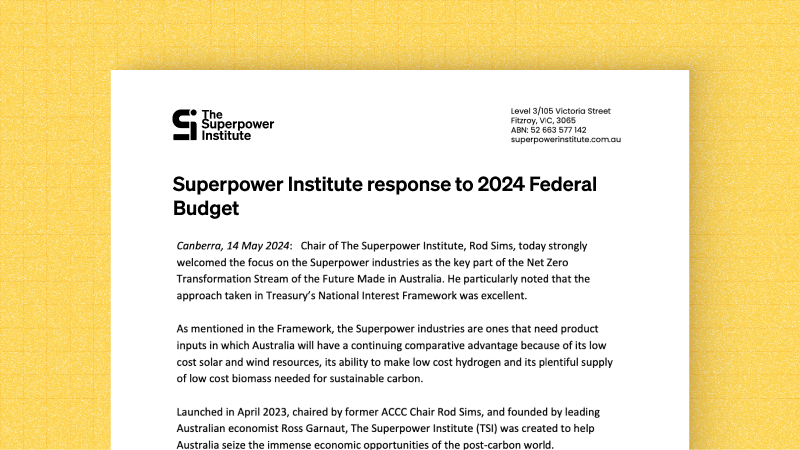Chair of The Superpower Institute, Rod Sims, today strongly welcomed the focus on the Superpower industries as the key part of the Net Zero Transformation Stream of the Future Made in Australia. He particularly noted that the approach taken in Treasury’s National Interest Framework was excellent.
As mentioned in the Framework, the Superpower industries are ones that need product inputs in which Australia will have a continuing comparative advantage because of its low cost solar and wind resources, its ability to make low cost hydrogen and its plentiful supply of low cost biomass needed for sustainable carbon.
Launched in April 2023, chaired by former ACCC Chair Rod Sims, and founded by leading Australian economist Ross Garnaut, The Superpower Institute (TSI) was created to help Australia seize the immense economic opportunities of the post-carbon world.
Chair of the Superpower Institute, Rod Sims, said: “It was extremely pleasing to see in the Net Zero Transformation Stream of the Future Made in Australia a complete focus on the Superpower industries, the need for Australia to have a comparative advantage in industries that are supported, and clear recognition of the two main market failures that, unless addressed, will lead the market to pick losers. As stated in the Framework it follows that support will necessarily be time limited.
“These market failures are the lack of a carbon price which means that green products do not compete on a level playing field with gas or coal products, because the latter do not pay for the damage they do to the environment.
“The other market failure is the need for support for first movers who bring known technology to scale despite inevitably making mistakes through ‘learning by doing’ which will cost them, but from which followers coming later will benefit.”
There was also recognition of the need for a role for government in providing common user infrastructure. The need to fast track project approvals was also recognised with $134m allocated to facilitate faster approval decisions. These are approaches long advocated by TSI.
“It was also pleasing to see Government recognition that Australia can make a significant contribution to reducing world emissions through exports from the Superpower industries.
"The Framework mentions that green iron/steel and green alumina/aluminium account for 13% of world emissions and that these are industries in which Australia can be a major world player," Rod Sims said.
Indeed, in addition to our just over 1% of world emissions now occurring in Australia, TSI estimates that we could remove around another 6-9% of global emissions that other countries will find very difficult to abate by making in Australia, for example, green iron, green aluminium and other processed minerals, green transport fuels, green urea and green silicon.
TSI estimates that by turning our iron ore into green metal alone Australia would reduce world emissions by well over 3%; triple the contribution to world emission reduction from decarbonising Australia.
Most of the $22.7bn allocated so far for the Future Made in Australia will go to production credits for hydrogen and critical minerals. The Framework document, however, leaves the door open to further funding to address the two market failures mentioned above in other areas, including areas that use hydrogen as an input to production.
“We particularly welcome the further consultation on new specific policies that will be needed to promote green iron/steel and aviation and shipping transport fuel production in Australia. There will clearly be more money available in addition to what is allocated in this Budget to address the effect of the market failures in these sectors. These are core Superpower industries that can contribute to Australia’s prosperity and to world emission reduction.”
As the Framework recognises, many other countries, particularly in Northeast Asia and Europe, do not have sufficient even moderate cost solar and wind resources to meet their own electricity needs. It follows that they will need to import many goods with the green energy intensity embedded in them to meet their climate targets.
“Australia’s advantages relative to the rest of the world are such that we can materially improve the prospects of achieving the world’s climate objectives,” Rod Sims said.
Australia’s advantages relative to the rest of the world are such that we can materially improve the prospects of achieving the world’s climate objectives.
The Superpower industries can also help strengthen Australia’s supply chains. “If Australia can make green aviation and shipping fuel, green polysilicon, processed green metals, and green fertiliser (urea) then we will be self-sufficient in areas vital to our economy. But we will be doing this in areas where we have a comparative advantage as these products variously need renewable energy, hydrogen and biomass, which Australia has and can make at the lowest cost”.
The Government is forecasting significant future budget deficits which makes funding the required additional money for the Net Zero Transformation Stream of the Future Made in Australia plus many other pressing needs difficult.
“As Australia continues to see the damage to the environment from fossil fuels, and as they realise the benefits to Australian prosperity and world emission reduction from the growth of the Superpower industries in Australia, there will be growing acceptance of The Superpower Institute’s proposed Carbon Solutions Levy that will turn the budget into surplus and allow, as examples, funding to support growth of the Superpower industries, needed services and structural tax reform,” Rod Sims said.

